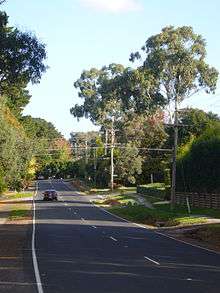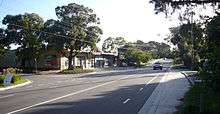Park Orchards, Victoria
| Park Orchards Melbourne, Victoria | |||||||||||||
|---|---|---|---|---|---|---|---|---|---|---|---|---|---|
 Park Orchards Location in metropolitan Melbourne | |||||||||||||
| Coordinates | 37°46′41″S 145°12′50″E / 37.778°S 145.214°ECoordinates: 37°46′41″S 145°12′50″E / 37.778°S 145.214°E | ||||||||||||
| Population | 3,718 (2011 census)[1] | ||||||||||||
| • Density | 590/km2 (1,529/sq mi) | ||||||||||||
| Postcode(s) | 3114 | ||||||||||||
| Area | 6.3 km2 (2.4 sq mi) | ||||||||||||
| Location | 23 km (14 mi) from Melbourne | ||||||||||||
| LGA(s) | City of Manningham | ||||||||||||
| State electorate(s) | |||||||||||||
| Federal Division(s) | Menzies | ||||||||||||
| |||||||||||||
Park Orchards is a suburb of Melbourne, Victoria, Australia, 23 km north-east of Melbourne's Central Business District in the local government area of the City of Manningham primarily, with a small portion (the southern side of Williams road) also located in the City of Maroondah. At the 2011 Census, Park Orchards, a Green Wedge area, had a population of 3,718 and is listed in the Australian Heritage Database.[2]
History

Pre-colonisation, the Wurundjeri people cared for the land.
In 1902, prominent Victorian orchardist Tom Petty, purchased 559 acres of land north of the Mitcham district, and converted it to 80 orchard blocks in an ambitious project.[3]
In 1925, South Melbourne timber merchants Australis Sharp and John Taylor purchased Petty's land and launched the Park Orchards Country Club Estate.[4] They had the subdivisions designed by Saxil Tuxen and Miller.[5] Tuxen had previously worked with Marion Mahony and Walter Burley Griffin on the Ranelagh Estate in Mt Eliza which Sharp and Taylor had owned, and Park Orchards was designed around a similar ‘Country Club’ organisation that had become popular during the 1920s in the US. The circular street layout is clearly inspired by Mahony-Griffin style.[6]
The Clubhouse, named "The Chalet", (c.1929) was built in a Spanish Mission style, featuring a blackwood panelled interior, with a ballroom and billiard rooms. The Estate failed to attracts buyers during the 1930s Depression and Sharp and Taylor cleared much of the land and planted plant pine trees (many which still remain) to provide for their timber yards.[7][8]
In 1944 the Australian Army requisitioned The Chalet and the football ground, and set up The School For Eastern Interpreters [9] for Z Special Unit [10] and a training facility for the Australian Special Wireless Group during World War II.[11][12][13][14][15][16][17] 400 personnel were stationed there, living in tents on the football ground, and they constructed the first water mains and connected to the electrical grid.[18]
In late 1946 Sharp & Taylor sold the Estate at auction to Edments Ltd, owners of a department store in Melbourne, with reported plans to develop part of it into a holiday resort for their staff.[19] They had a 9-hole golf course and cricket ground constructed in the 1950s.
By the late 1950s the Post-War Migration boom [20][21] saw an increase in subdivisions being developed. Most of the blocks were sold by 1960. The Park Orchards Post Office opened on 1 November 1959,[22] the Primary School opened on 14 March 1961.[23] The final blocks sold in the early 1990s.
The Chalet was the location of the first Catholic mass in Park Orchards in 1965.[24] From the 1970s it was used as Restaurant and Reception Centre,[25] and hosted the wedding of Mick Gatto in 1978.[26] In 1994 the exterior was Heritage listed by the local council.[27] The Chalet was sold in 2007, the new owners shut it down and submitted an application to build an Aged Care facility.[28] The local council rejected the application. In 2009, the local community failed in an attempt to raise $1.5m to purchase the property with the aim of turning it into a community centre.[29] In 2010 VCAT determined, contrary to the local council ruling, that a planning permit should be issued, albeit with a requirement for reticulated sewerage services to be established. Later in 2010 the Park Orchards Ratepayers Association submitted both the Chalet and original Estate area to be registered as places of significance by the Heritage Council, but the application was rejected as not meeting the minimum criteria. As of 2015 the Chalet remains unused and neglected of maintenance.
Facilities

Park Orchards features a small commercial-zoned area on Park Rd (spread over either side of Hopetoun Rd) with around 20 lots.
There are two local primary schools and a number of private and state secondary schools in close proximity. The two primary schools are Park Orchards Primary School (POPS) (public), which hosts a monthly Farmers Market, and St. Anne's (private).
Park Orchards Reserve is home to the Basketball Centre, Community House, Tennis Club, Children's Service Centre, Pre-school and Playground.
There are several other public reserves, including a large 41 hectare area of natural bushland known as 'The 100 Acres'.
Horse riding is a popular pastime in the area, with facilities including Helmast Park providing agistment and riding arenas, along with others in nearby Warrandyte.
Sporting clubs
The suburb features the Domeney Reserve & Recreation Centre, which hosts the home games of the Park Orchards Cricket Club and the Park Orchards North Ringwood Parish Sharks Junior Football Club, and the Park Orchards Football Club of which long-time local Kevin Sheedy is the number 1 ticket holder,[30] as well as the Yarra Valley Old Boys Football Club.
The suburb is also home to the Park Orchards Tennis Club, the Steelers Basketball Club, the Park Orchards Netball Association and BMX Club.
Domeny Reserve and several roads in the area were used during the 1960s up until 1975 by the Austin 7 Club as part of their Observed Section Trials (Mud Trials).[31]
See also
- City of Doncaster and Templestowe - the former local government area of which Park Orchards was a part.
References
- ↑ Australian Bureau of Statistics (31 October 2012). "Park Orchards (State Suburb)". 2011 Census QuickStats. Retrieved 22 July 2012.
- ↑ "Park Orchards Country Club Estate & The Chalet, Brucedale Cr, Park Orchards, VIC, Australia". Australian Government - Department of the Environment.
- ↑ "Park Orchard Country Club Estate and Chalet - Doncaster & Templestowe Heritage Stufy" (PDF). Department Of Infrastructure. Victorian Government.
- ↑ "Green, Irvine, and Betty Beavis, Park Orchards: a short history, Doncaster-Templestowe Historical Society, Melbourne, 1983.". The School of Historical & Philosophical Studies, The University of Melbourne. Retrieved 6 March 2015.
- ↑ "Park Orchards". eMelbourne. School of Historical & Philosophical Studies, The University of Melbourne.
- ↑ "Park Orchards History". PORA. Park Orchards Ratepayers Association.
- ↑ "Park Orchards Estate and the Chalet Park Orchards Heritage Council Registrations Committee Decision". http://www.dtpli.vic.gov.au/. Department of Transport, Planning and Local Infrastructure. Retrieved 6 March 2015. External link in
|website=(help) - ↑ "Victorian Places - Park Orchards". Monash University & The University Of Queensland. Retrieved 6 March 2015.
- ↑ MacLaren, Roy (2004). Canadians Behind Enemy Lines, 1939-1945. UBC Press. p. 198. ISBN 0774811005.
- ↑ ""Z" Special Unit in Australia during WWII". OzAtWar. Peter Dunn.
- ↑ "Spy twins' top-secret war". The Australian Newspaper.
- ↑ "Australian Special Wireless Group, AIF in Australia during WW2". Australia @ War.
- ↑ "David Sissons and D Special Section" (PDF). Australian National University.
- ↑ Breaking Japanese Diplomatic Codes: David Sissons and D Special Section During the Second World War. ANU E Press. 2013. ISBN 1925021084.
- ↑ Smith, Michael (2000). The Emperor's Codes: The Breaking of Japan's Secret Ciphers. Arcade Publishing. ISBN 155970568X.
- ↑ "WRAAC Newsletter December 2009" (PDF). Women's Royal Australian Army Corps Association (VICTORIA) Inc. WRACC.
- ↑ Padula, Bob. "Wartime HF communications station in Melbourne". The Australian Shortwave Radio Journal.
- ↑ "A Brief History of Park Orchards". Hoskins. Hoskins Real Estate.
- ↑ "The Argus". 21 December 1946.
- ↑ "The changing face of modern Australia – 1950s to 1970s". australia.gov.au. Australian Government.
- ↑ "Fact Sheet 4 – More than 65 Years of Post-war Migration". Department of Immigration and Border Protection. Australian Government National Communications Branch, Department of Immigration and Border Protection, Canberra.
- ↑ Premier Postal History, Post Office List, retrieved 11 April 2008
- ↑ "Park Orchards Primary School". Retrieved 6 March 2015.
- ↑ "Our History". Parish of St. Gerard & St. Anne.
- ↑ "The Age". 31 May 1985.
- ↑ Gatto, Mick (2011). I, Mick Gatto. Victory Books. p. 46. ISBN 0522860664.
- ↑ "Statement of Significance". Victorian Heritage Database. Heritage Victoria.
- ↑ "War Icon's Battle". The Weekly Review Eastern. Metro Media Publishing.
- ↑ "PARK ORCHARDS CHALET INFORMATION MEMORANDUM" (PDF). Park Orchards Tennis Club. Park Orchards Community.
- ↑ "Sharks' Own Sheedy". Footy EFL. Eastern Football League.
- ↑ "60 Year Booklet" (PDF). Austin 7 Club of Victoria. Austin 7 Club inc.